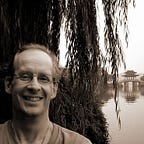Wanderment in the City
Wandering the liminal spaces puts us in touch with ancient energy.
Scientists say our hominid ancestors first stood upright millions of years ago. To witness your baby take his/her first steps remains one of life’s most beautiful miracles. The first steps are followed by a long line of footprints that inevitably wander away, towards an individual horizon. Wandering is our lifeblood. There is an Old Norse word — “Flana” which means to wander with no purpose. Our spirit has a strong longing for or impulse toward wandering. People get valuable health benefits from walking a few thousand steps a day even at a leisurely pace. But there is more to wandering than the physical health benefits. I see too many people stride at full steam down the beach, seldom stopping to marvel at the wonders on display. It seems they have an appointment to keep with the end of their walk.
The health benefits of walking are manifold. Some benefits for those over Fifty include: improved circulation; lightens your mood; lose weight; strengthen muscles; improve sleep; slow down mental decline; Studies have show that for people in their 50s and 60s with underlying health conditions are 45% less likely to die over the next eight years when compared to non-walkers. But simply wandering refreshes the spirit and puts us in contact with our natural origins.
Exploration is in our nature. We began as wanderers, and we are wanderers still. We have lingered long enough on the shores of the cosmic ocean. We are ready at last to set sail for the stars. — Carl Sagan Not everyone has access to a long deserted stretch of beach or wooded path, but anyone who lives in a city does have access to what the unstructured borderlands between town and countryside which have been called edgelands. This wild partially untamed area bordering the urban landscape is our liminal space. A liminal space is a transitional boundary between two states — as in a rite of passage, or two ecosystems — farm and woods/city and grassland/. This can be extended to aesthetically to an airport in the middle of the night or even an empty hallway in a hotel. Have you ever had that feeling when walking into an long, empty hotel hallway that something unseen is there with you? When traveling, you stop at a rest stop between home and your destination, and there is some disorientation on how to navigate the space. All these are experiences of liminal space. Liminal means threshold. And you can harness that liminal energy can increase your wellbeing.
There is a certain sense of pride that comes with wandering along with no particular place to go. In fact, there is a word in French Flâneur — A stroller; wanderer of the city and the crowd. To quote Baudelaire “ The crowd is his element, as the air is that of birds and water of fishes. His passion and his profession are to become one flesh with the crowd…” People were encouraged to immerse themselves in the city. This all flowed from modernity resulting from the Age of Reason. The development of modern cities changed the social order and human relationships to the built environment. One modern example of a flaneur would be a street photographer. One of the great joys of travel is simply wandering in a new place.
Being confined to a tour chafes my independent nature. I have only been on one official tour to Beijing with my wife for her birthday. It was right before the 2008 Olympics. The best part of the tour was when we got into a car chase through the city’s ancient back-alley hutongs in the tour guide’s van — but that is another story. Living in a city has many advantages, but one great disadvantage is the lack of access to nature. For example, statistically 100 million Americans do not live within a ten minute walk of park. I learned this statistic because October 10 is National Walk to a Park Day. Even if there is no park nearby, you can wander along your city’s sidewalks and roadways. Take note of the transitional spaces between the paved and the unpaved. Primordial energy pulses there — you can feel it in your feet and the curling of your toes, taste it in the unconscious deeper breath. There is a delightful children’s poem by Shel Silverstein — Where the Sidewalk Ends. Which speaks to this urging towards the liminal areas, just off the paved pathways and byways.
Many writers and artists found inspiration during walks, whether in the city or in nature. Ambling along simply being in your own skin is a form of meditation. The word meditation carries such an unnecessary psychic weight. There does not have to be a series of steps, or ritual performance. Anyone who has ever gone swimming knows the feeling of anticipation just before plunging into the water. Standing on the solid one second and immersed in liquid the next, surfacing to grab some air the next — you are literally awash in transitional energy. A similar energy rises in the pulse when wandering along. Your body desires the feeling of wanderment — the act of wandering, roaming.
There is an indefinable, mysterious power that pervades everything. I feel it, though I do not see it. It is this unseen power that makes itself felt and yet defies all proof, because it is so unlike all that I perceive through my senses. It transcends the senses — Mahatma Gandhi
